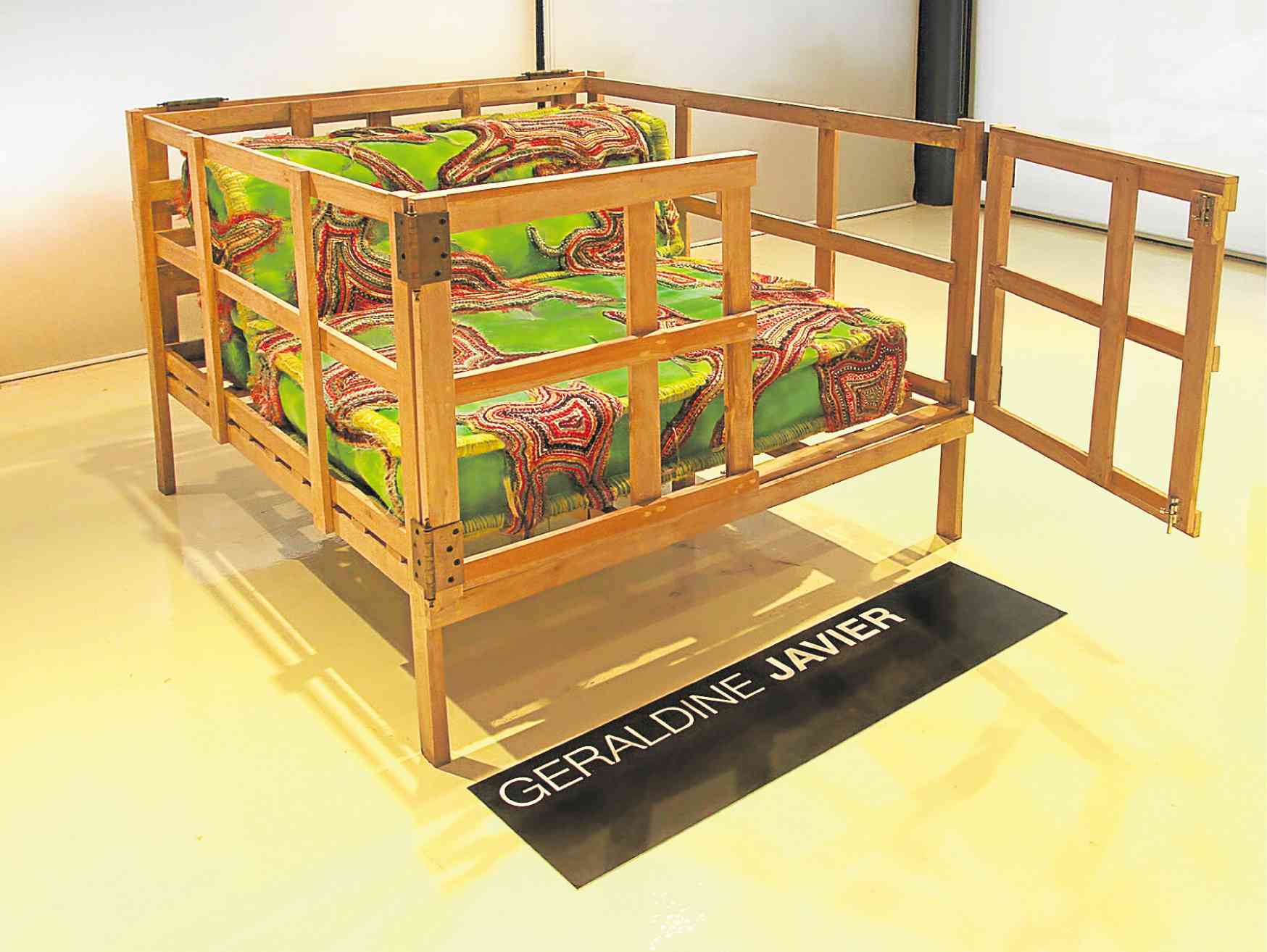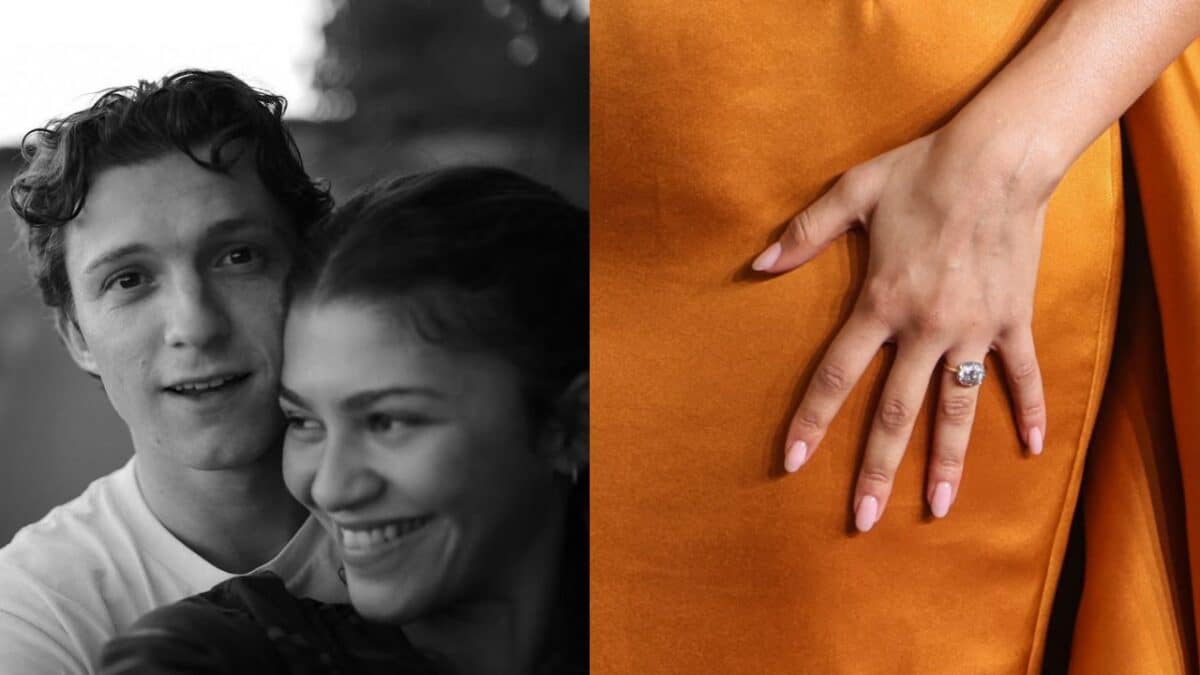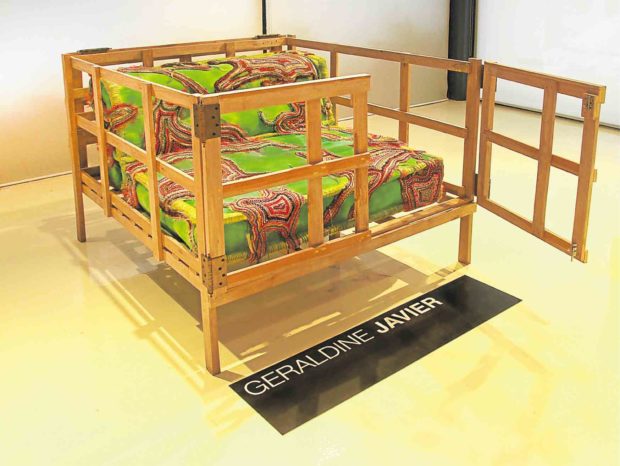
A pregnant 15-year-old girl pleaded for her life when she and her 20-year-old partner were being targeted by the police for suspected drug abuse. She ended up as “collateral damage” in President Duterte’s drug war.
However, it wasn’t only the merciless killing that bothered artist and women’s rights advocate Nikki Luna. She has been meeting with families whose daughters have become victims of extrajudicial killings (EJK).
Luna’s art echoes what she thinks is the hypocrisy of our norms. She cites that under Philippine law, the age of consent is low. A 12-year-old is legally old enough to engage in sex.
It inspired a signature piece, the Mah Jong Sofa, of a French furniture company.
Luna created a simple white seater with neon lights screaming “Dangerous Times.”
She points out the irony of her statement piece, an homage to poor and defenseless human rights victims. Yet the people who can afford the sofa live in comfort and are shielded from harsh realities.
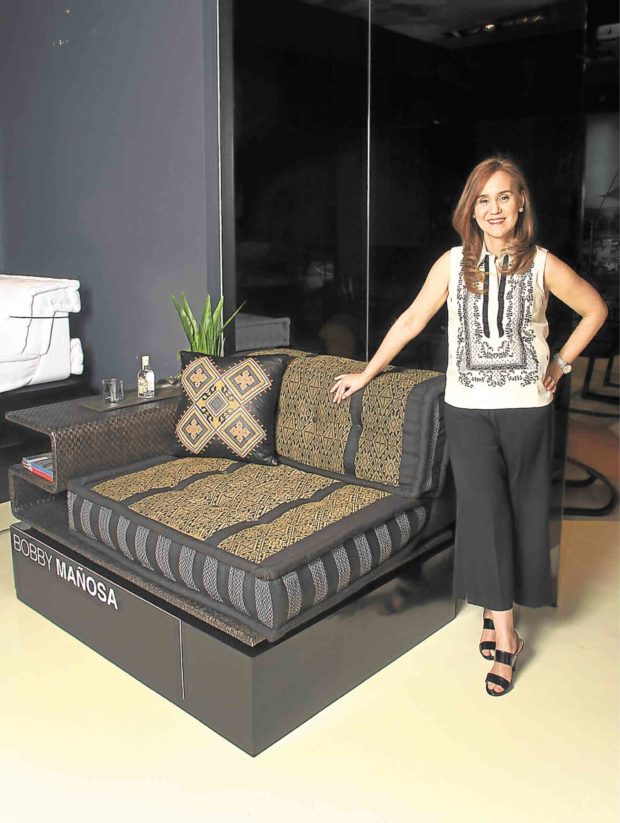
The artist chose white upholstery to symbolize society’s two-faced view of purity. While decency and honor are valued, women are not given equal rights to maintain their dignity.
She hopes that “Dangerous Times” will spark conversations.
Top seller
Through the years, Roche Bobois has been collaborating with designers to dress up the Mah Jong Sofa, created by Hans Hopfer in the 1970s.
Hopfer created a modular sofa, which ushered in a casual approach to living. Composed of three elements, the Mah Jong Sofa can be arranged into a lounge chair, armchair or bed.
Roche Bobois Manila has invited 10 artists and designers from different fields to interpret the Mah Jong Sofa. Their works will be auctioned on Sept. 19 at Whitespace, Makati. Part of the proceeds will go to the artist’s chosen charities, such as Tukod Foundation, AHA Learning Center and Asian Cultural Council.
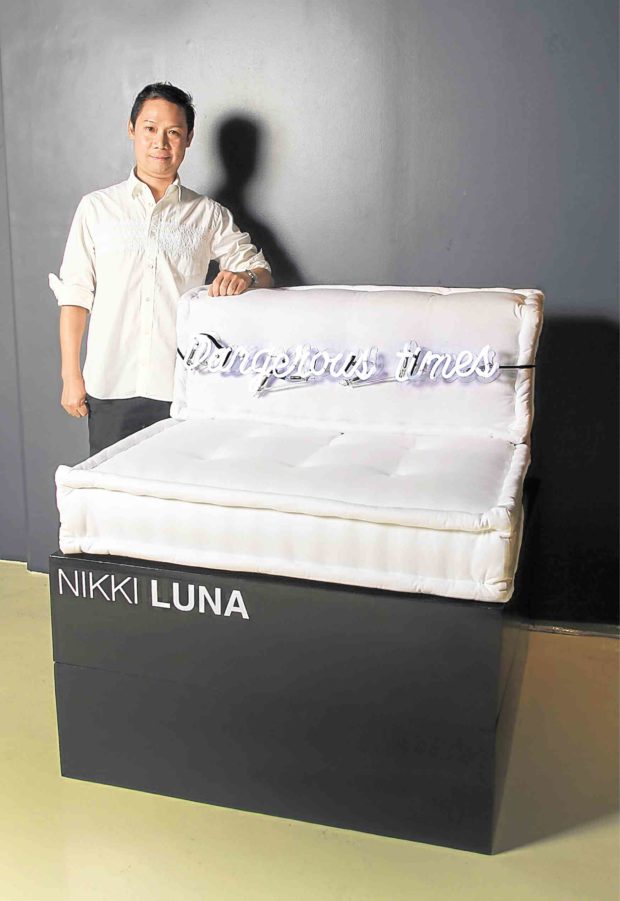
Eugene Gordon Lorenzana, managing director of Roche Bobois Manila, says the Mah Jong Sofa is a world top seller.
Local prices range from P70,000 to P90,000. Clients can have the sofa customized. It takes six months to produce a sofa in Italy.
For this exhibit-auction, titled “Interactions,” the artists were given the Mah Jong to treat like a blank canvas.
“The aim is to marry Filipino artistry with French design,” says Lorenzana.
Community and quirks
Multimedia and installation artist Geraldine Javier also takes a social stance, though on a lighter note. Her Mah Jong Sofa is a patchwork of German shepherds in different poses, covered with imported yarns. The chair has a wooden frame that symbolizes a cage.
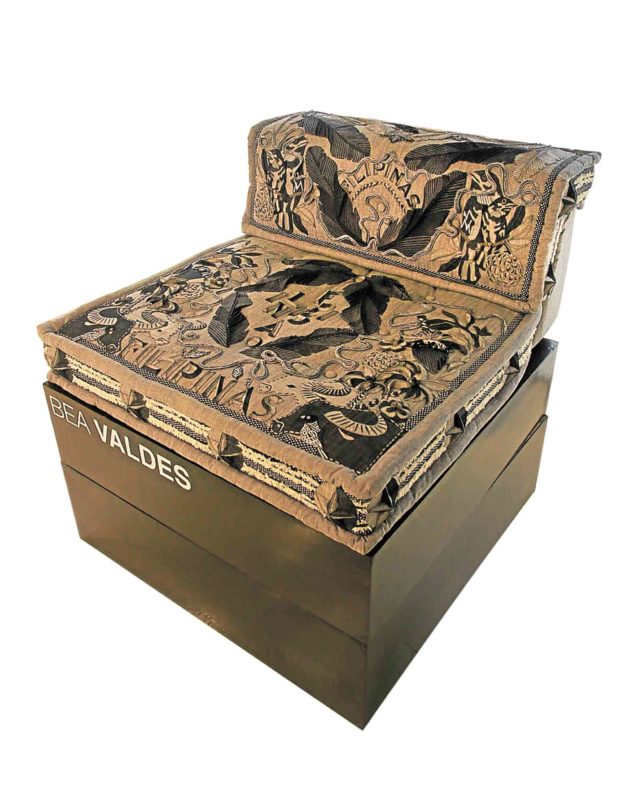
In Cuenca, Batangas, Javier trains mothers from underprivileged neighborhoods. They get paid to work on her artworks and installations. Women bring their children as they sew.
“The chair is about community and how we take care of each other, including our pets,” says Javier. “I have 10 dogs and two cats. My youngest is the German shepherd. The wooden frame around the chair symbolizes a cage. The door is open so that freedom can be enjoyed.”
Javier has chosen the Philippine Animal Welfare Society as beneficiary.
Bea’s banana trees
Accessories designer Bea Valdes’ take on the Mah Jong also imparts the idea of community in her work.

She is inspired by banana trees outside her atelier and old Filipino engravings and bank notes. The dark tones of denim and chambray lend a vintage feel.
Some 20 women sewed on cutouts of stars, flora, fauna and the letters of “Filipinas.” They embroidered the designs and frayed the edges of the fabric.
The process took six months of experimenting and layering to produce a three-dimensional effect.
Paloma’s ‘inabel’
Paloma Urquijo, founder of the hip Filipiniana fashion brand Piopio, aims to keep the indigenous textile tradition alive. She collaborated with a master weaver, Manang Cora, from Santiago, Ilocos Sur.
Urquijo shows the modern interpretation of inabel, the traditional handwoven blanket from the North. The Mah Jong Sofa is covered with warm and neon colors of inabel, with images of human figures, horsemen, stripes, fish and diamonds.
“We wanted to stay true to the tradition of the inabel and its iconic patterns,” says Urquijo. “These patterns have been passed down the generations, and we want to keep passing them on for many more to come.”
Some artists showed their idiosyncrasies on rendering of the Mah Jong Sofa.
Zicarelli’s rawness
The works of Constancio Zicarelli are described as “deviant and morose.” The rawness of his art provokes shock or dislike.
His chair is spray-painted, varnished and coated in enamel in black and brown. To get a grungy and textured effect, he also used graphite and charcoal powder.
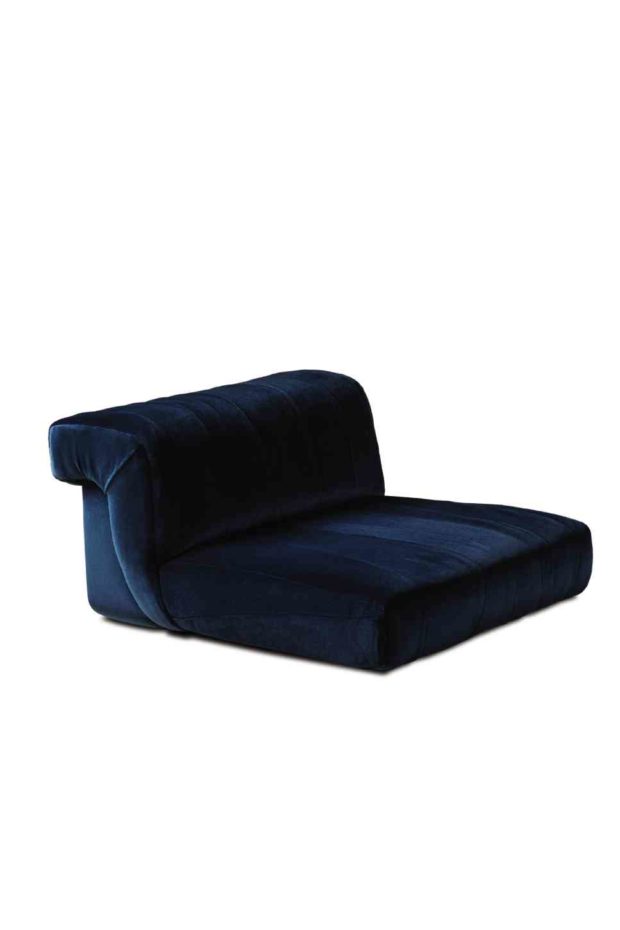
The gothic look is offset by the softness of his mother’s crocheted doily. “The outcome was too raw. I put something familiar and classic for contrast,” he says.
Abstract
From a distance, abstractionist Jojo Lofranco’s chair is a canvas of shapeless strokes, highlighted by a strip of neon light.
As in most of his works, the hues are difficult to determine. The reds and blacks are toned down with white paint, while the yellows are intensified. The abstraction of bold strokes exudes energy.
Representatives from design and architecture have taken a practical approach.
Selma’s functional art
Vito Selma stays true to the Filipino theme. A jeepney rider, he is fascinated by the driver’s seat made of hand-sewn wooden beads.
“I wanted to translate that into furniture, not necessarily an artwork. It has to be functional,” says Selma.
The Mah Jong is covered with a removable “apron” made of pinewood beads in different shades for a three-dimensional illusion. The pinewood is imported from New Zealand’s reharvested forests.
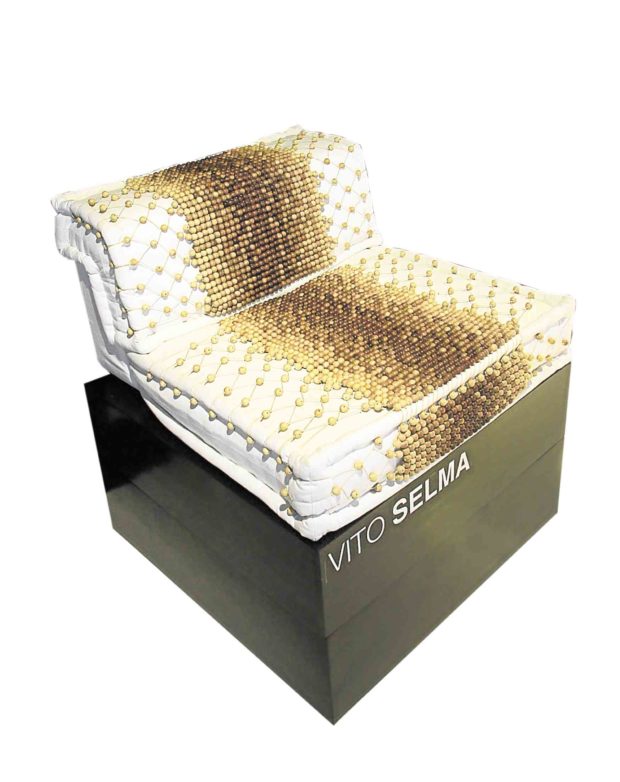
“In design, people think that wood is hard. I wanted it to be comfortable. The chair and the beads follow the contour of the body. It’s like second skin,” Selma says.
The best part is that the wooden apron can be removed so that it can be washed and folded.
Tribute to Mañosa
Interior designer Bambi Mañosa pays tribute to her 87-year-old father, Francisco, proponent of Filipino architecture. The Mah Jong reflects the patriarch’s design precept of marrying Filipino elements with function.
“My father’s philosophy is that architecture and design must stay true to itself, the land and the people,” says Mañosa.
The architect draws influences from Luzon, Visayas and Mindanao. Hence, the chair features Mindanao’s tribal patterns—Yakan bunga patterns on the backrest and a T-boli cross-stitched accent pillow in leather—and the Cordilleras’ cuabao, or diamond motif, on the seat.
Made of laminated rattan, the frame and side table take after the tikog weave of Samar.
The chair has a practical appeal. One can put magazines and books on the side table, or a gin tonic—the Mañosa patriarch’s favorite drink after work.
Calma’s minimalism
Interior designer Chat Fores recalls a childhood exposed to Orientalia. She cut her mother’s vintage silk obi sashes and layered them diagonally on the upholstery. The patterns on the bolster were derived from Fores’ old necklines. The ends of the bolster are adorned with old patterned Chinese plates.
Known for his minimalism, architect Ed Calma wrapped the chair in midnight blue fabric with a subtle metallic sheen.
“The fabric feels luxurious, but layering it creates an architectural surface,” says Calma. “I always believe that architecture is more important than decoration. Form, scale and proportion are timeless compared with ornamentation.”
He adds that the pleating gives the illusion of architectural paneling. —CONTRIBUTED

